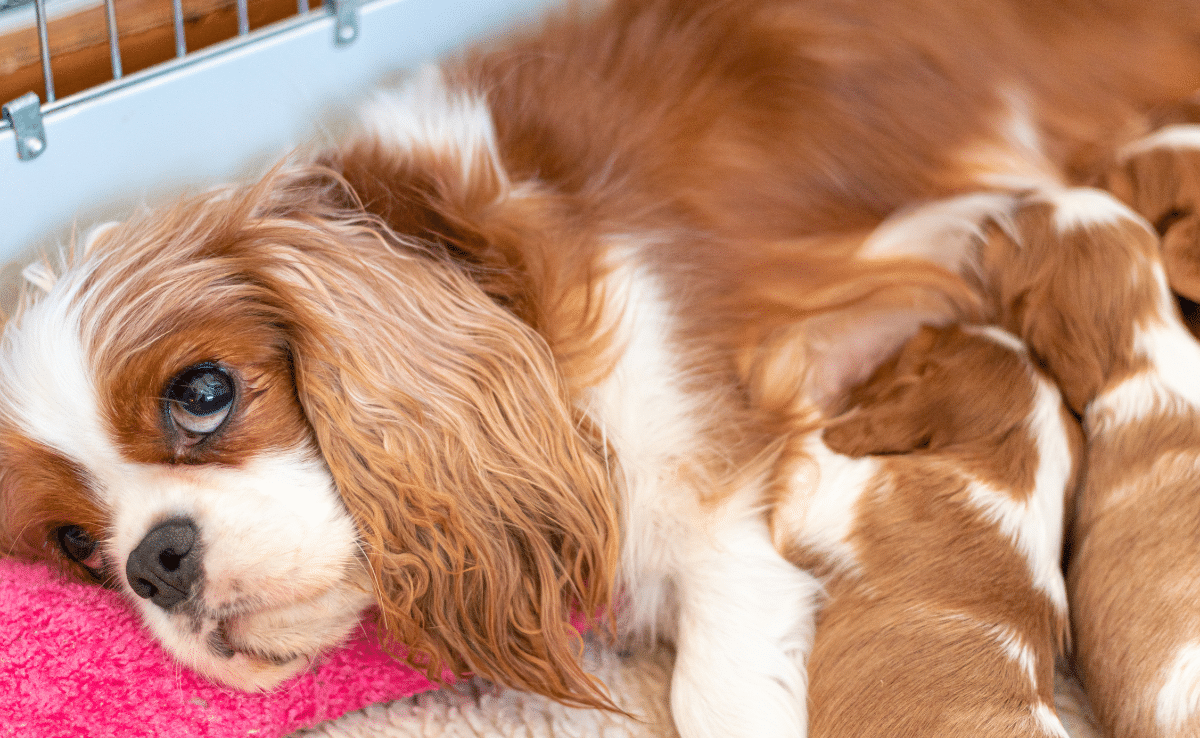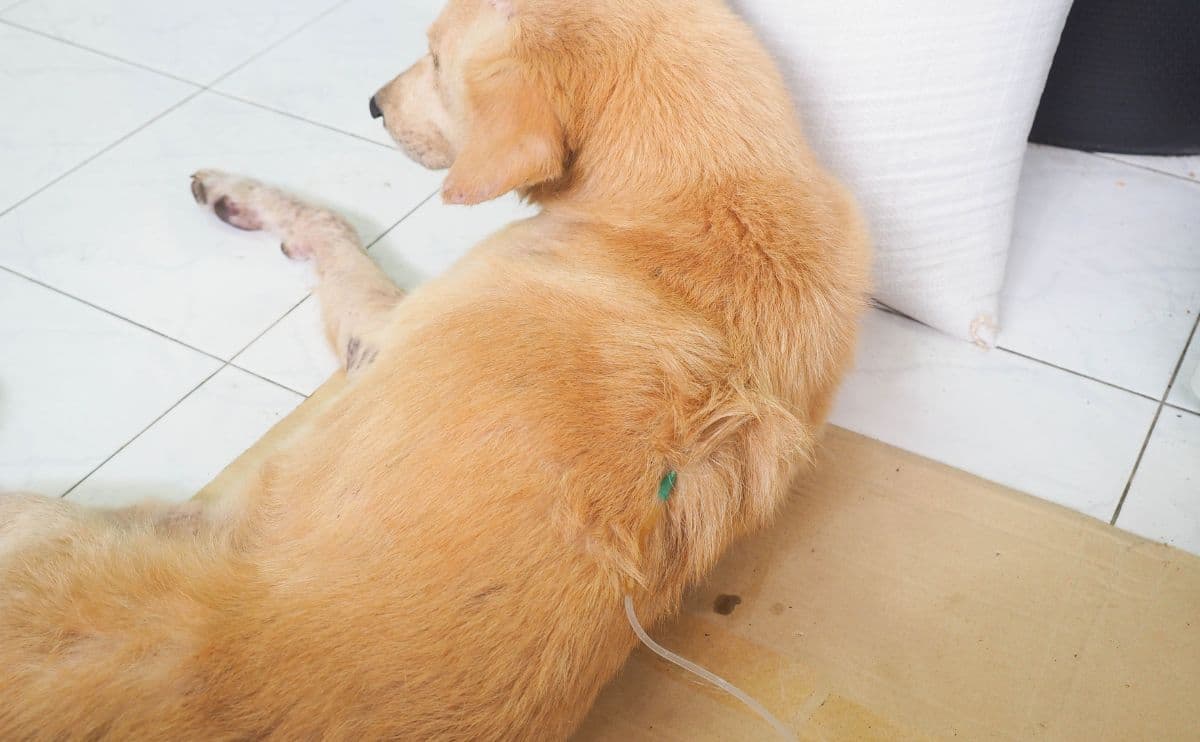When you purchase through links on our site, we may earn a commission. Here’s how it works.

Mastitis in dogs is a painful condition that can progress rapidly and make nursing dogs very sick quickly. Mastitis is an inflammation of the mammary glands due to milk accumulation or bacterial infection. It mainly affects female dogs, and the majority of those that are affected are pregnant or feeding puppies. Mastitis is a treatable condition. However, if left untreated can lead to a serious infection, so veterinary help should be sought as soon as possible. So, what does mastitis look like in dogs? How should you treat a swollen mammary gland in dogs? And why does mastitis occur?
What Is Mastitis In Dogs?
Mastitis is a term used to describe inflammation of a mammary gland or breast tissue. Dogs have five pairs of mammary glands, starting near the axillary (armpit) region and extending back to the inguinal (groin) region. Each mammary gland has a nipple, so dogs have ten or so mammary glands and nipples in total.
Both male and female dogs have mammary glands, but mastitis is rare in male dogs. Mastitis is more common in female dogs that are pregnant or have recently whelped and are feeding puppies as the mammary tissue is active and producing milk. However, mastitis can also occur in bitches that are having a phantom pregnancy. Mastitis is rare in bitches that have been neutered (spayed) as their hormone levels are low, and the mammary tissue is inactive.
What Causes Mastitis In Dogs?
In most cases, mastitis is caused by a bacterial infection. Trauma to the nipple or teat canal can allow bacteria to enter, traveling up into the mammary gland and resulting in infection. Puppies feeding from their mother can cause accidental trauma to the teat. Accumulation of milk in the mammary gland is also a risk for mastitis. This occurs when puppies are not suckling from a particularly mammary gland or puppies are suddenly weaned, leading to decreased milk removal from the glands.
Mastitis In Dogs Symptoms
Symptoms of dog mastitis vary depending on the severity and cause of the infection. You may notice that your dog has a swollen nipple (dog nipple infection), or in more severe cases all of the mammary tissue can become swollen and inflamed. One or more mammary glands may be affected at a time.
If your dog has mastitis, you may notice the following symptoms:
- Teats that are red or inflamed
- Teats that are hot to touch
- Teats that are painful to touch
- Milk may appear discolored with blood (red) or pus (green/yellow)
- Lumpy mammary tissue
- Reluctance to nurse puppies or aggression toward puppies
- Restlessness
- Reduced appetite
- Fever
- Lethargy
Severe, early-stage mastitis in dogs can result in a rapidly progressive fever. Dogs with a fever may be hot to the touch, they are often lethargic and have a reduced appetite, and may shiver or tremble. You may notice these signs before any changes to the mammary glands.
Gangrene mastitis in dogs is a very severe infection that is, thankfully, very rare. In gangrenous mastitis, the teat and surrounding tissue appear black, bruised, and large open wounds may develop. The milk is often bloody, and the mother will be very unwell with symptoms such as vomiting, fever, decreased appetite, and collapse.
How Is Mastitis In Dogs Diagnosed
A veterinary surgeon will diagnose mastitis based on a clinical examination of your dog. They may need to perform additional tests, such as blood tests to assess your dog’s immune status and hydration status, and screen for further problems, such as a calcium imbalance that can be associated with the infection. A sample of the pus, or infected milk, may be taken to isolate the bacteria involved and guide treatment options.
Mastitis In Dogs Treatment
Treatment of mastitis in dogs depends on its severity. If the infection is mild, puppies will be allowed to continue nursing, which is good for both the mother and her puppies. In more severe infections, the mother may be too ill to nurse her puppies, and they will have to be bottle-fed either in the short or long term. Before giving any medication to your dog, be sure to check it is safe to give if they are nursing puppies.
Many dogs with mastitis can be treated at home with antibiotics, anti-inflammatories, and pain-relieving medication. If the infection is severe, dogs may need to be hospitalized for intravenous fluids, intravenous antibiotics, and more intensive management of the condition. In rare cases, abscessed or gangrenous glands may require surgical removal or treatment under general anesthesia.
Mastitis in dogs caused by phantom pregnancy is often treated with hormone treatment to reduce the size of their mammary glands and dry up the milk.
Dog Mastitis Home Treatment
How to treat mastitis in dogs is an age-old question that has been asked by generations of breeders. Many are keen to provide treatment at home to avoid the stress of moving a dog that has recently whelped or is about to go to the veterinarian. However, mastitis infection can progress quickly, and it is always advised to seek veterinary advice if you suspect mastitis in your dog.
Home remedies for mastitis can include using a warm or cold compress on the mammary tissue to reduce inflammation. Alternate between the two holding each on the affected gland for up to 20 minutes at a time. Topical treatments such as manuka honey, aloe vera, or peppermint may provide some relief and cool the inflamed tissue.
It is important to avoid puppies ingesting this, so it may not be suitable for nursing bitches.
How To Prevent Mastitis In Dogs
The best tips for preventing mastitis in dogs are as follows:
- Keep the environment and whelping box clean to reduce bacterial contamination of the teats when nursing
- Carefully clip or file the edges of puppies’ nails to stop them from scratching their mother’s skin and causing trauma
- Keep the mother’s skin clean around the mammary glands when feeding puppies. Clip any excess hair and use a gentle shampoo or saline wash to clean the skin daily, ensuring that the skin is thoroughly dried after.
- Ensure that all mammary glands are used for nursing to avoid milk accumulation. Hand-strip milk from engorged mammary glands.
Frequently Asked Questions
What is the best antibiotic for mastitis in dogs?
Many antibiotics are suitable for use in mastitis in dogs. An ideal antibiotic is one that penetrates into the milk well, has a broad spectrum of activity that targets the common bacteria found in mastitis infections, and is safe to use in pregnant and lactating bitches. In some cases, your vet will take a sample of the mild or infected fluid to choose the most suitable antibiotic. This test is known as culture and sensitivity.
Are cabbage leaves for mastitis in dogs a good treatment?
Cabbage leaves may have some benefits. They release natural anti-inflammatory chemicals and can be used as a cold compress when applied directly to the mammary tissue. But they are not a substitute for veterinary treatment and should only be used to manage mastitis following advice from a veterinary surgeon.
Can dogs get mastitis when they are not pregnant?
Dog mastitis in non-pregnant dogs is less common but can occur. Mammary enlargement in dogs that are not having puppies may suggest a hormone imbalance, such as a phantom pregnancy. Bitches that have aborted their litter may still produce milk and be at risk of mastitis.
A Healthy Dog Mom Is A Happy Dog Mom
Bringing puppies into the world can be a very exciting time for pet parents. However, it is important to regularly check on mom’s health too. Dogs that are about to give birth, or have recently given birth, are at risk of a number of health problems, including mastitis. Mastitis can lead to severe infections, which, at their worse, can be life-threatening for dogs. If you suspect your dog has mastitis, don’t delay in seeking veterinary advice. The sooner they are treated, the sooner they can get back to being the best dog mom they can be. Learn more about how long dogs are pregnant, how to deal with a dog in heat, and find out if pet insurance covers pregnancy-related expenses like C-sections.
Tagged With:

